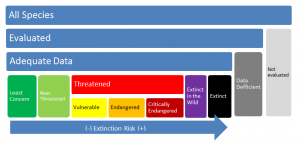Ecosystem services, values to humans based on the state of the environment (in this case terrestrial biodiversity) can be used to outline what the effects of loss of biodiversity are. Although ecosystem services relate explicitly to humans, they often have complementary effects on the environment. Some examples of ecosystem services that are benefited by biodiversity are detailed below.
Provisioning
Food
Increases in biodiversity result in increases in plant production (Winfree, 2013). This is because plant diversity increases plant production since multiple species can be more productive than a single species as they can occupy a greater range of niches. This leads to increases up the food web due to bottom-up effects and has positive impacts on humans because, for example, meat from wild animals is a critical food source for many countries.
Water quality
Ecosystems with greater species richness are more effective at removing nutrients from water. Excessive nutrient content is considered a leading cause of global water pollution (Cardinale, 2011).
Human health
Biodiversity loss lowers the quantities of raw materials available for the discovery of potential drugs and biotechnology and effects the spread of human diseases (Alves & Rosa, 2007).
Regulating
Carbon fixation
Plants take in CO2 as they undergo photosynthesis and change it into organic carbon (Cain, Bowman, & Hacker, 2014, p. 113). Increased plant production from increased biodiversity (see 4.1.a.i.) results in more photosynthesis and thus more carbon fixation. The reduction of atmospheric CO2 , a greenhouse gas, reduces global warming and therefore biodiversity has a positive effect on both humans and the environment.
Biological control
Plant biodiversity promotes resistance to invasive species by lowering their ability to establish or thrive due to increases in crowding (Lugnot & Martin, 2013).
Pollination
Declines in pollinator biodiversity result in extinctions of other plant species (Abrol, 2012). Insect pollination, mostly by bees, is necessary for 75% of all crops that are used directly for human food worldwide (Abrol, 2012). In this way, declines in pollinator diversities contribute to other biodiversity declines along with lower food crop supplies for humans.
Stability & resilience
Biodiversity contributes to ecosystem resilience, including the ability to continue to provide ecosystem services in changing environmental conditions (Sukhdev, Wittmer, Schröter-Schlaack, & Nesshöver, 2010). Biodiversity stabilizes ecosystem function over space or time by response diversity: different species have different responses to environmental change (Winfree, 2013).
Supporting
Soil fertility, & structure
Biodiversity has several positive effects on soil including increases organic matter content, better nutrient cycling and the promotion of water retention (Lugnot & Martin, 2013). This allows farmers to need less fertilizer and to be able produce food more efficiently (which in turn have positive environmental effects such as reducing the driver or food production.
Cultural
Aesthetic value
Humans, especially in developed countries, tend to value complexity and diversity in their surrounding landscapes such as wildflowers, or while bird watching (Tscharntkea, et al., 2012).
*The impacts of the current state (e.g. decline) of biodiversity are outlined by the ecosystem services, above. These impacts inspire responses from human society.*
